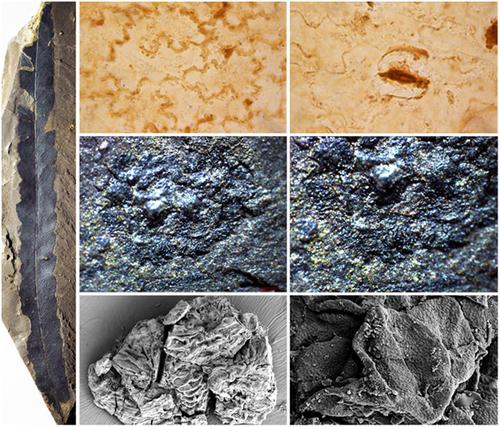当前位置:
X-MOL 学术
›
J. Syst. Evol.
›
论文详情
Our official English website, www.x-mol.net, welcomes your feedback! (Note: you will need to create a separate account there.)
Fossil pinnae, sporangia, and spores of Osmunda from the Eocene of South China and their implications for biogeography and paleoecology
Journal of Systematics and Evolution ( IF 3.7 ) Pub Date : 2020-06-24 , DOI: 10.1111/jse.12653 Xiao‐Yan Liu 1, 2, 3 , Yong‐Dong Wang 3, 4 , Li Wang 1 , Ning Zhou 3, 5 , Li‐Qin Li 3, 4 , Jian‐Hua Jin 1
Journal of Systematics and Evolution ( IF 3.7 ) Pub Date : 2020-06-24 , DOI: 10.1111/jse.12653 Xiao‐Yan Liu 1, 2, 3 , Yong‐Dong Wang 3, 4 , Li Wang 1 , Ning Zhou 3, 5 , Li‐Qin Li 3, 4 , Jian‐Hua Jin 1
Affiliation

|
The genus Osmunda L. contains approximately 10 extant species widely distributed in tropical and temperate regions, with the greatest concentration of species in East and Southeast Asia. Osmunda is characterized by dimorphic or commonly hemidimorphic fronds with dimorphic pinnae. Its geological history has been traced back to the Triassic. Most records of the genus are based on rhizomes and rarely on pinnae bearing sporangia and spores. Here, we describe fossil pinnae, sporangia, and spores of Osmunda lignitum (Giebel) Stur recovered from the middle Eocene of the Changchang Formation in the Changchang Basin, Hainan Island and the Youganwo Formation in the Maoming Basin, Guangdong, South China. The fossils closely resemble the extant Osmunda banksiifolia (C. Presl) Kuhn of the subgenus Plenasium on the basis of their morphological and anatomical structures. The present occurrence of O. lignitum indicates subg. Plenasium flourished and extended from the high latitude regions such as Northeast China to the low latitude areas of South China during the middle Eocene. Large numbers of specimens described here also indicate that Osmunda was the dominant understory fern element beneath mixed evergreen broad-leaf angiosperm and gymnosperm forests living in a warm and humid environment.
中文翻译:

华南始新世紫薇的羽片、孢子囊和孢子化石及其对生物地理学和古生态学的意义
紫薇属包含约 10 种现存物种,广泛分布于热带和温带地区,其中东亚和东南亚的物种最集中。紫薇的特征是具有二形羽片的二形或通常是半形的叶子。它的地质历史可以追溯到三叠纪。该属的大多数记录基于根茎,很少基于带有孢子囊和孢子的羽片。在这里,我们描述了从海南岛长昌盆地中始新世和广东茂名盆地油干窝组中发现的紫薇(Giebel)Stur的化石羽片、孢子囊和孢子。这些化石与现存的非常相似基于其形态和解剖结构的紫萁亚属( Plenasium)的紫薇(C. Presl)库恩。O. lignitum的当前出现表明 subg。中始新世,斑蝥从东北等高纬地区向华南低纬地区蓬勃发展。这里描述的大量标本还表明,在生活在温暖潮湿的环境中的常绿阔叶被子植物和裸子植物混合林下,紫薇是主要的林下蕨类植物元素。
更新日期:2020-06-24
中文翻译:

华南始新世紫薇的羽片、孢子囊和孢子化石及其对生物地理学和古生态学的意义
紫薇属包含约 10 种现存物种,广泛分布于热带和温带地区,其中东亚和东南亚的物种最集中。紫薇的特征是具有二形羽片的二形或通常是半形的叶子。它的地质历史可以追溯到三叠纪。该属的大多数记录基于根茎,很少基于带有孢子囊和孢子的羽片。在这里,我们描述了从海南岛长昌盆地中始新世和广东茂名盆地油干窝组中发现的紫薇(Giebel)Stur的化石羽片、孢子囊和孢子。这些化石与现存的非常相似基于其形态和解剖结构的紫萁亚属( Plenasium)的紫薇(C. Presl)库恩。O. lignitum的当前出现表明 subg。中始新世,斑蝥从东北等高纬地区向华南低纬地区蓬勃发展。这里描述的大量标本还表明,在生活在温暖潮湿的环境中的常绿阔叶被子植物和裸子植物混合林下,紫薇是主要的林下蕨类植物元素。


























 京公网安备 11010802027423号
京公网安备 11010802027423号